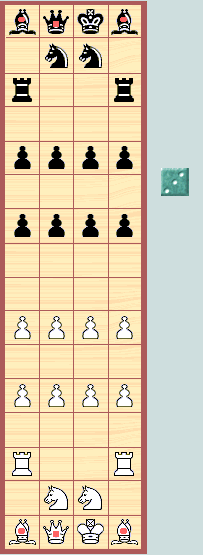

Oblong Shatranj with die is a medieval chess variant played on an oblong board of 4x16 = 64 squares. Win is achieved by capturing the opponent’s king. Alternatively, win is achieved by making the enemy king “bare”, that is, alone on the board. The players have the same pieces as in Shatranj, namely a king that moves one square in any direction; a general (firzan) that moves diagonally one step; two fils that jump diagonally two steps; two knights that move like chess knights; two rooks (rukh) that correspond to chess rooks, and eight pawns that move like chess pawns, except that there is no initial double-step. The today uncommon pieces general and fil have been marked with a red spot to remind the player that they move in the medieval manner. These medieval pieces are better suited for this game than modern chess pieces.
The die decides which piece can be moved. When rolling a six, the player may move the king, when rolling a five, the player may move the general, when rolling a four, the player may move a fil, when rolling a three, the player may move a knight, when rolling a two, the player may move a rook, and when rolling a one, the player may move a pawn. When no move is possible, then the turn is lost.
Unlike in regular chess it’s allowable to pass moves. However, in my interpretation, it’s not allowable to pass on pawn-moves, except when they are blocked. If you want to (or must) pass a move, then you must signal this by lifting and dropping the king. Note that you are obliged to perform this procedure even if the die shows the number of a piece that you don’t own anymore. In the historical record, there are seven different opening setups known for this game.
Discussion
Oblong Shatranj with die is an about thousand year old variant of Shatranj, the Arabic pre-decessor of modern chess. It is my conjecture that this game, besides entertainment, was used for divination purposes, like Madagascan Fanorona. It strikes me as very suitable for this purpose. Today, it’s even better suited for this, as you can set the computer to play against itself. With this implementation you can become a chess geomancer! Study how the play unfolds. Try to foretell the future, and get councel from the movement of the pieces.
As the position is very crammed, the pawns should be moved away so that the squares that they occupy become vacant for your knights and fils. Don’t be afraid to take risks now and then, and put a pawn, knight or fil, en prise in order to get into the enemy position. The chances that a piece will get captured is about fifty-fifty if the square it treads upon is threathened by only one type of enemy piece. There is sometimes much to gain by taking risks. Unlike regular chess, if a piece is lost, this does not mean that the game is lost. When the position is later opened up and the heavy rooks enter upon the scene, then an active rook can win the game fast, even for the party that is at a material disadvantage. Besides opening the files, remember that there is an alternative solution to activating the rooks. One can push a pawn so that a rook can advance on the same file and maneuver itself so that it can take up a position ahead of the pawn-chain. Oblong Shatranj with die is a slow game. A typical game would take at least eighty moves. But it is not a deep-thought game so it goes fast anyway.
As this game was also played without die, also variants without die have been implemented. The difference is that checkmate, and stalemate, are the objectives. Alternatively, win is achieved by making the enemy king “bare”, that is, alone on the board (but this rule is not enforced).
(Don’t miss my other chess variants.)
You can download my free ‘Oblong Shatranj with die’ program here (updated 2006-05-09), but you must own the software Zillions of Games to be able to run it.
© M. Winther 2006